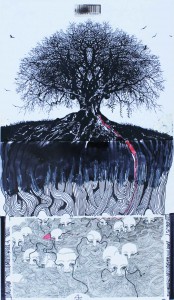Botond Részegh
NIGHTFALL – Botond Részegh’s Art
Botond Részegh’s Nightfall is an intensely personal, overarching narrative. The suite of paintings bears the imprint of the spirit of a people, their homeland, and its tortured history. Részegh resides in Miercurea Ciuc, Romania, an isolated and veiled town on the mountainous border of eastern Transylvania. He draws on sentimentality and the sociopolitical conditions of his homeland for inspiration or for a means to convey penetrating screams. Deeply engaged in the exchange of ideas between past and present, the domain within and the world without his studio, Részegh assumes the role of reporter and analyst in an exploration of momentous historic events and everyday realities.
Nightfall was influenced by the tenor of the times during the controversial sentencing and ten-year imprisonment of Mikhail Khodorkovsky, the former Russian oligarch and opponent of President Vladimir Putin. For Részegh, the fate of the tycoon also represents that of political prisoners worldwide, by his assertion, “This is about freedom…. This is about how we choose our own path.” It is against this backdrop that Részegh expresses the day-to-day realities of his economically and socially distressed environs. As artists are the antennae of society, he invokes images that are a direct result of the anguish, solitude and generalized uneasiness of life for many. His works are emotional, personal and powerful; they tend to play on our sensibilities and, as viewers, we are drawn into their psyches.
The commanding effect of the canvases derives from the way in which the bodies and body fragments are posed and positioned. The artist represents himself as an orator with neither eyes nor mouth. He says much but leaves enough silence in each work to arouse an overt response and stimulate our sensations. His disembodied forms represent a springboard to express his view of humankind’s precarious existence. In this regard, Nightfall is also a commentary of the artist’s personal observations of the death and dying experiences. As observers, we are compelled to open up before the artwork, as our visual systems struggle with the tempered hues of his bold and emotionally charged fragments of bodies. Hauntingly beautiful, his work frequently mines the subconscious.
Nightfall’s imagery is raw. The emotional impact that Részegh’s work evokes hinges not only on his imagery of figures but also on the manipulation of paint—smudging faces and bodies into blurred and unstructured terrestrial-like beings, always in seclusion and anguish. While his two-dimensional language is clean, sharp and economical, the play in value gives it depth, and the thick patina gives it complexity. There is as much inward contemplation as there is outward exchange, interpreted and internalized by the viewer, in these stylized and surreal works. Time and patient observation are required to fully appreciate the technical brilliance of his art as well as the deeply felt emotion and honest sincerity expressed therein. His work allows us to enter his personal life.
Botond Részegh’s oeuvre functions as an effective arbiter upon which he works about his private feelings and sensations; they sum up the artist’s introspective world. Részegh is shouting to be heard, effectively sublimating into his art the ear-piercing bellowing of the need to release, the need to scream. Nightfall is the artist’s mournful ballad.
There are trace influences of other artists on Botond Részegh. He is a respected member of Romanian and Hungarian intellectual arts circles, where the intersection of the plastic and literary arts are valued and practiced. Visual artists who directly influence his output include Francis Bacon, Rembrandt, Mimmo Paladino, Cy Twombly, Philippe Guston—more recent painters include Susan Rothenberg, Gottfried Helnwein, Rashid Johnson’s post-black paintings, and Rainer Wölzl. He draws inspiration from writers such as Dostoevsky, Rainer Maria Rilke, Ludmila Ulickaya, György Dragomán, and Dimitri Verhulst.
Debra Vanderburg Spencer, Curator
Botond Részegh
1 June 1977
www.reszeghbotond.ro
Represented by
Léna & Roselli Gallery Budapest
CCA & A Gallery Hamburg
Personal exhibitions (selection)
2015: “Nightfall” curated by Anamaria Altmann,
Romanian Culture Institute, Vienna (Austria)
2014
“Nightfall” Tranzit House, Cluj Napoca (Romania)
“Nightfall” Tipografia Gallery- Bucharest (with catalogue)
VOLTANY, Volta Show- New York
360 Gallery, curated by Isabel Meirelles, Boston (with brochure)
2013
Joella Gallery, Turku, Finland
Galeria IX- Budapest (Hungary)
„Ad hoc”, Új Kriterion Gallery, Miercurea Ciuc
Galeria 26, curated by Simona Vilău Bucharest (with brochure)
2011
Galeria IX- Budapest (Hungary) (with catalogue)
Léna&Roselli Gallery – Budapest (Hungary)
2010
Northeastern University curated by Isabel Meirelles
– Boston (with catalogue)
Art Fairs, Courtesy of Léna & Roselli Gallery
2014: VOLTANY, Volta Show- New York
2013: Art Market Budapest- Budapest (Hungary
2009: „Budapest Art Fair”- Budapest (Hungary)
2009: Slick Art Fair- Paris (France)
2009: Lineart: Ghent- Belgium
2008: „Budapest Art Fair”- Budapest (Hungary)


